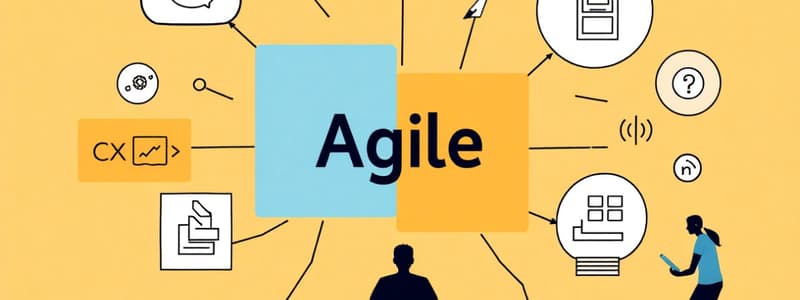Podcast
Questions and Answers
Which conversion strategy is considered the riskiest and least expensive?
Which conversion strategy is considered the riskiest and least expensive?
- Phased conversion
- Direct conversion (correct)
- Pilot conversion
- Parallel conversion
What primary role does a Scrum master play in agile development?
What primary role does a Scrum master play in agile development?
- Maintains project processes (correct)
- Conducts user requirement sessions
- Represents the business users
- Develops the software systems
In the design thinking process, which step involves understanding the user's perspective regarding the problem?
In the design thinking process, which step involves understanding the user's perspective regarding the problem?
- Define
- Empathize (correct)
- Prototype and test
- Ideate
What is the primary goal of DevOps in software development?
What is the primary goal of DevOps in software development?
Which of the following describes a characteristic of Rapid Application Development (RAD)?
Which of the following describes a characteristic of Rapid Application Development (RAD)?
End-user development can sometimes lead to which major concern within an organization?
End-user development can sometimes lead to which major concern within an organization?
What is the primary purpose of an IT strategic plan?
What is the primary purpose of an IT strategic plan?
Which of the following is NOT an objective of the IT strategic plan?
Which of the following is NOT an objective of the IT strategic plan?
What role does the IT steering committee play in the planning process?
What role does the IT steering committee play in the planning process?
What must organizations do before agreeing on an IT strategic plan?
What must organizations do before agreeing on an IT strategic plan?
What is an application portfolio?
What is an application portfolio?
Which element is crucial for developing the IT strategic plan?
Which element is crucial for developing the IT strategic plan?
What is a common challenge companies face when calculating the costs of IT investments?
What is a common challenge companies face when calculating the costs of IT investments?
Which method is used to convert future values of benefits to present-value equivalents in cost–benefit analysis?
Which method is used to convert future values of benefits to present-value equivalents in cost–benefit analysis?
What does the break-even analysis determine?
What does the break-even analysis determine?
Which of the following is a method to justify funding specific IT projects?
Which of the following is a method to justify funding specific IT projects?
When considering the purchase of prewritten applications, what is an important factor for companies?
When considering the purchase of prewritten applications, what is an important factor for companies?
What does leasing an application typically save a company?
What does leasing an application typically save a company?
What is the significance of the '80/20 rule' when evaluating vendor software?
What is the significance of the '80/20 rule' when evaluating vendor software?
Which aspect of IT project benefits is particularly difficult for organizations to evaluate?
Which aspect of IT project benefits is particularly difficult for organizations to evaluate?
What is the primary focus of systems analysis in the systems development life cycle?
What is the primary focus of systems analysis in the systems development life cycle?
What is a key disadvantage of outsourcing IT applications?
What is a key disadvantage of outsourcing IT applications?
In the systems design phase, what is a deliverable expected from this process?
In the systems design phase, what is a deliverable expected from this process?
What occurs if functions are added after the project has been initiated in systems design?
What occurs if functions are added after the project has been initiated in systems design?
What does the feasibility study primarily evaluate?
What does the feasibility study primarily evaluate?
Which phase in the systems development life cycle involves translating design specifications into computer code?
Which phase in the systems development life cycle involves translating design specifications into computer code?
What is the role of application service providers (ASPs)?
What is the role of application service providers (ASPs)?
Which job role is involved in deciding whether to build a new system based on user suggestions?
Which job role is involved in deciding whether to build a new system based on user suggestions?
What is a core characteristic of Software-as-a-Service (SaaS)?
What is a core characteristic of Software-as-a-Service (SaaS)?
What type of software allows users to customize and develop applications without payment for licenses?
What type of software allows users to customize and develop applications without payment for licenses?
Flashcards
Application Portfolio
Application Portfolio
A prioritized list of existing and potential IT applications, created by examining company needs and performance.
IT Strategic Plan
IT Strategic Plan
Long-range goals describing IT infrastructure and initiatives needed to achieve organizational goals.
IT Architecture
IT Architecture
How an organization utilizes information resources to accomplish its mission.
IT Steering Committee
IT Steering Committee
Signup and view all the flashcards
IT Planning
IT Planning
Signup and view all the flashcards
Organizational Strategic Plan
Organizational Strategic Plan
Signup and view all the flashcards
IT Operational Plan Elements
IT Operational Plan Elements
Signup and view all the flashcards
Cost-Benefit Analysis
Cost-Benefit Analysis
Signup and view all the flashcards
Fixed Costs (IT)
Fixed Costs (IT)
Signup and view all the flashcards
Net Present Value (NPV)
Net Present Value (NPV)
Signup and view all the flashcards
Return on Investment (ROI)
Return on Investment (ROI)
Signup and view all the flashcards
Lease Option (IT)
Lease Option (IT)
Signup and view all the flashcards
80/20 Rule (Software)
80/20 Rule (Software)
Signup and view all the flashcards
Application Service Provider (ASP)
Application Service Provider (ASP)
Signup and view all the flashcards
Software-as-a-Service (SaaS)
Software-as-a-Service (SaaS)
Signup and view all the flashcards
Open-source Software
Open-source Software
Signup and view all the flashcards
Outsourcing
Outsourcing
Signup and view all the flashcards
Continuous Application Development
Continuous Application Development
Signup and view all the flashcards
Custom Development
Custom Development
Signup and view all the flashcards
Systems Development Lifecycle (SDLC)
Systems Development Lifecycle (SDLC)
Signup and view all the flashcards
Systems Investigation
Systems Investigation
Signup and view all the flashcards
Technical Feasibility
Technical Feasibility
Signup and view all the flashcards
Economic Feasibility
Economic Feasibility
Signup and view all the flashcards
Direct Conversion
Direct Conversion
Signup and view all the flashcards
Pilot Conversion
Pilot Conversion
Signup and view all the flashcards
Phased Conversion
Phased Conversion
Signup and view all the flashcards
Joint Application Design (JAD)
Joint Application Design (JAD)
Signup and view all the flashcards
Rapid Application Development (RAD)
Rapid Application Development (RAD)
Signup and view all the flashcards
Agile Development
Agile Development
Signup and view all the flashcards
Study Notes
IT Application Planning and Justification
- Organizations analyze application needs, justifying purchases based on goals, costs, and benefits.
- An application portfolio prioritizes existing and potential IT applications.
- IT planning starts with the organizational strategic plan, outlining mission, goals, and steps to achieve them.
- The IT strategic plan is aligned with the organizational plan, defines an IT architecture, and efficiently allocates resources.
- The IT steering committee links corporate strategy, approves resource allocation, and sets measures for the MIS function.
- The IS operational plan details specific projects for the IS department and functional areas, including mission, environment, objectives, constraints, portfolio, resource allocation and management.
Evaluating and Justifying IT Investment
- Cost-benefit analysis compares the costs and benefits of IT investments.
- Calculating IT investment costs involves allocating fixed costs across projects and considering long-term maintenance and improvement expenses.
- Evaluating benefits is often subjective and difficult to quantify, particularly intangible ones.
- Companies may pilot new technologies to assess functionality and consumer acceptance.
- Cost-benefit analysis methods include NPV, ROI, break-even analysis, and business case development.
Strategies for Acquiring IT Applications
- Purchasing pre-written software is cost-effective and time-saving. Careful consideration of features is needed to avoid obsolescence.
- Customizing pre-written software is flexible but can be complex, demanding thorough planning.
- Leasing applications saves both time and money. The 80/20 rule suggests adapting business processes to leverage software that meets 80% of needs.
- Application service providers (ASPs) or Software-as-a-Service (SaaS) vendors host applications, eliminating installation and maintenance costs.
- Open-source software offers a flexible alternative via licenses.
- Outsourcing to external contractors can provide access to experts. Offshoring, particularly to India and China, may offer lower costs but presents communication risks.
- Continuous development steadily adds new code to a project.
- Custom development offers better fit to specific requirements.
Traditional Systems Development Life Cycle (SDLC)
- The SDLC is a structured framework for large-scale IT projects.
- Six processes define the SDLC: investigation, analysis, design, programming, implementation, and operation/maintenance.
- Systems investigation uses feasibility studies (technical, economic, and behavioral) to evaluate solutions.
- Systems analysis gathers information on the existing system for defining system requirements.
- Systems design specifies system outputs, inputs, processing, user interfaces and hardware/software specifications.
- Approved design specifications are "frozen" to prevent scope creep.
- Programming translates design specifications into code.
- Testing assures the code meets expected results.
- Implementation involves transitioning to the new system. Direct, pilot, and phased strategies exist.
- Operation and maintenance involve ongoing support and updates.
Alternative Methods and Tools for Systems Development
- Joint Application Design (JAD) is a group-based method to gather requirements.
- Rapid Application Development (RAD) combines JAD, prototyping, and ICASE tools for rapid system development.
- Agile development delivers functionality in short iterations, emphasizing frequent communication and user involvement using techniques like Scrum and MVP.
- DevOps integrates development and operations teams to speed up deployments.
- End-user development—sometimes shadow IT—allows users to develop apps without IT help.
- Design thinking prioritizes user needs to create successful applications
- Prototyping uses iterative models to refine the system.
- Computer-aided software engineering (CASE) tools automate various SDLC tasks. ICASE tools integrate upper and lower CASE.
- Component-based development uses reusable components.
- Object-oriented development models real-world entities as objects – properties and behaviors.
- Containers package applications with their needed environments for consistency.
Studying That Suits You
Use AI to generate personalized quizzes and flashcards to suit your learning preferences.




